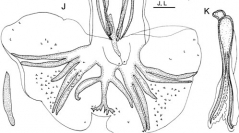

 Zoosystema
22 (1) - Pages 5-14
Zoosystema
22 (1) - Pages 5-14Description of Ornithostrongylus volcani n. sp. (Nematoda, Trichostrongylina, Heligmosomoidea) a parasite of Zenaidura auriculata (Aves, Columbidae) and Molineus inexpectatus n. sp. (Molineoidea) a parasite of Lachesis mutus (Squamata, Crotalidae), both from Venezuela. Ornithostrongylus volcani n. sp. is closely related to O. cramae Vigueras, 1934, a parasite of the same host in Cuba, particularly in the semi-circular shape of the externo-lateral branches of the spicules. It is distinguished from O. cramae, mainly by the relative arrangement of rays 2 to 8 of the caudal bursa, and, in the female, by the presence of a vulvar ala. O. hastatus (Linstow, 1905), a parasite of Phasianiformes in Europe, having a 2-1-2 pattern of the caudal bursa cannot be classified either in the genus Ornithostrongylus, or in the Heligmosomoidea. The lack of information does not allow us to classify it in a particular genus. O. cramae, synonymized by Yamaguti (1961) with O. quadriradiatus (Stevenson, 1904), a parasite of Columbia livia from U.S.A. is considered valid. Molineus inexpectatus n. sp. is closely related to M. mustelae Schmidt, 1965, a parasite of Mustelidae in the U.S.A. It is mainly differentiated by a smaller number of cuticular ridges, the shape of the spicules and by the presence of cuticular expansions at the level of the excretory pore. The interpretation of the presence of this species in a snake is discussed, the genus Molineus being cosmopolitan parasites of Carnivora and neotropical primates.
Nematoda, Trichostrongylina, Ornithostrongylus volcani n. sp., Heligmosomoidea, Molineus inexpectatus n. sp., Molineoidea, Columbidae, Crotalidae, Venezuela.